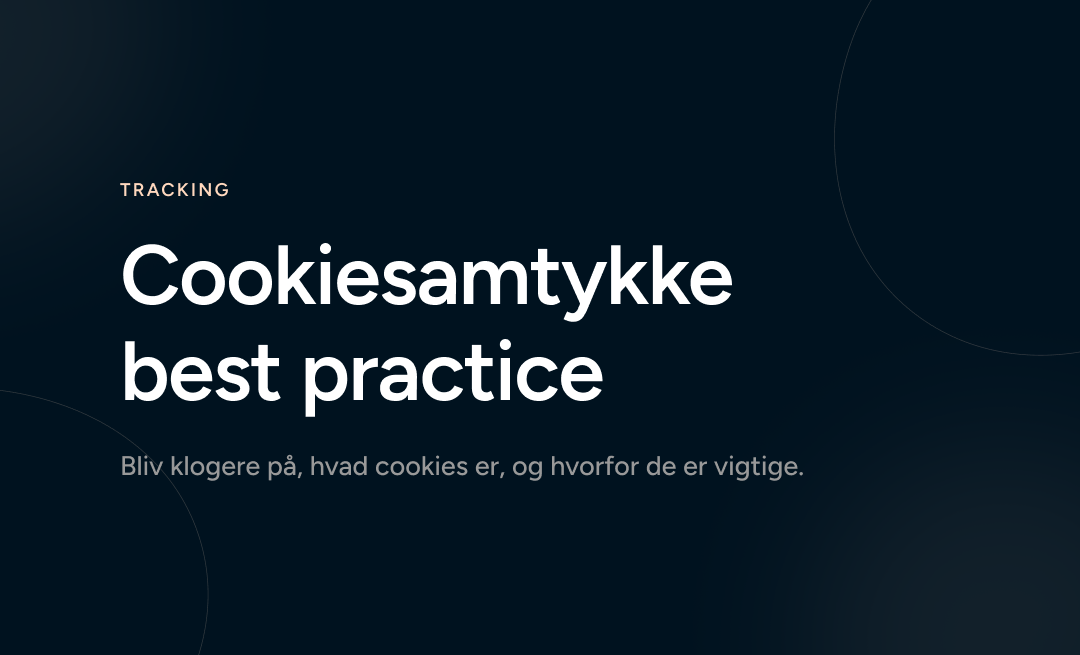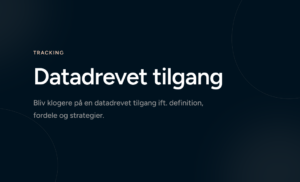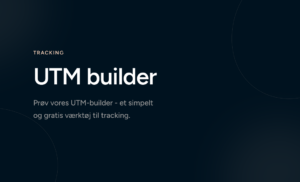Tracking
26. januar 2023
Cookiesamtykke best practice: effekten som banner positionen har på opt-in raten

Der er sket meget på cookiefronten de sidste 2 år, og det er nu soleklart, at alle websites skal have et cookiesamtykke-banner og følge reglerne for GDPR-compliance.
Det er forventet, at websites og services er transparente omkring deres dataindsamling practices og, at de giver klar og kortfattet information om de typer cookies de bruger, hvad den indsamlede data bruges til og sidst men ikke mindst give brugerne muligheden for at acceptere eller afvise cookies, der indsamler data.
Hvis ikke de gør det, kan de blive frataget retten til at bruge services som Google Ads og i sidste ende i bøder.
I dette indlæg vil jeg ikke gå i dybden med hvad cookies er, hvorfor du har brug for dem, eller hvordan du implementerer et cookiesamtykke. I stedet vil jeg fokusere på den effekt cookiesamtykket har på den data du indsamler på dit website (primært den statistiske marketing data), og hvad vi kan gøre for at få flere brugere til at acceptere cookies og dermed forbedre denne data.
Tab af data grundet cookiesamtykke
Da vi implementerede cookiesamtykke på morningbound.dk, faldt trafikken øjeblikkeligt med ~40%. Selvfølgelig mistede vi ikke ~40% af vores besøgende, men vi mistede 40% af vores data i Google Analytics. Det er ret betydeligt for en virksomhed, der afhænger af omhyggelig lead tracking, og som bruger de indblik til at guide vores marketing strategi.
Eftersom både EU og Google nu insisterer på, at alle websites uanset hvilken data de indsamler, skal være GDPR-compliant, så nytter det ikke noget at prøve at undgå at sætte cookiesamtykket op. Vi måtte derfor finde andre måder at forbedre vores dataindsamling.
Den eneste mulige måde at gøre det på var ved at få flere brugere til at acceptere cookies, så vi på den måde kunne fortsætte med at indsamle statistisk marketingdata.
Hvad man ikke skal gøre med samtykke-banneret
Reglerne for hvordan du er GDPR-compliant, er strikse og ret klare:
- Det er ikke tilladt at ’nudge’ brugeren til at give samtykke. Så at have en grøn ”Accepter alle cookies” knap og en rød ”Afvis” er ikke ok
- Det er ikke tilladt, at mulighederne allerede er valgt (for eksempel med en check-box der allerede er fyldt)
- Brugeren skal have muligheden mellem Accepter, Afvis og den valgfrie nødvendige cookies. Det er ikke tilladt blot at informere brugeren om, at cookies anvendes, hvis han/hun vælger at bruge siden
Så hvis vi ikke må forsøge os med farverne på knapperne, og vi er mere eller mindre låste i det indhold, der vises i cookiesamtykke-banneret, hvad er der efterhånden så tilbage vi kan prøve?
Altså der er jo stadig placeringen af banneret.
Kan placeringen af cookiesamtykke-banneret virkeligt have effekt på opt-in raten?
Selvfølgelig har placeringen af cookie-banneret indflydelse på opt-in raten. Brugerne vil være mere tilbøjelige til at lægge mærke til et samtykke-banner, der er placeret i en mere fremtrædende position på websitet.
De vil også være mindre tilbøjelige til at lægge mærke til eller bruge tid på at læse det, hvis det forsvinder i designet på siden, eller er placeret ”af vejen” som f.eks. helt i toppen af siden.
Et studie der undersøgte implementering af cookies i EU, viste at 64,6% af websites placerer deres cookie-banner i bunden af skærmen, 27,2% placerer det i toppen og kun 7,8% placerer det i midten. Det samme studie konkluderede også, at opt-in raten er højest når banneret er placeret i bunden.
Tankerne er at placeringen af banneret i bunden er mere tilbøjelig til at dække noget af sidens indhold og på den måde opfordrer det brugeren til handling, hvorimod cookiebannere placeret i toppen er nemmere at ignorere (ignorere ikke overse – vigtig forskel).
Men bare fordi brugerne er mere tilbøjelige til at handle, betyder det ikke nødvendigvis, at de accepterer cookies. At ignorere og at afvise dem har den samme effekt, da cookies ikke begynder at indsamle data, før brugeren giver samtykke til det.
Så hvis vi går med den sidste tanke (at brugerne bliver irriteret over at indhold på siden bliver dækket og derfor bliver ”tvunget” til at handle set fra et lidt negativt perspektiv), kan vi så ”opfordre” kunden mere ved at bruge en full screen cookie pop up? Og hvordan vil det påvirke opt-in raten?
Vi satte vores eget eksperiment op for at finde ud af det 😊
Eksperimentet
Eksperimentet blev sat op med Cookiebot. Cookiebot har en log for hver brugerinteraktion med cookie-samtykket, som kan downloades fra deres website.
Vi startede med vores som et cookiesamtykke-vindue overlay (centreret med resten af skærmen mørk) i 2,5 måneder efterfulgt af 2,5 måneder med samtykke-banner i bunden af skærmen.
Vi satte det samme eksperiment op (i en 2 måneders periode dog) på flere af vores B2B kunders websites, for at se om der var væsentlige udsving.
Hvorfor udelukkende B2B kunder tænker du måske? B2B virksomheder har ofte et højt antal besøgende fra andre virksomheder. Disse besøgende bruger med stor sandsynlighed en desktopenhed (Cookiebot bruger forskellige layouts baseret på enhed), og er mere tilbøjelige til at bruge hvad end browser, deres IT-afdeling har sat op for dem (højst sandsynligt uden nogen form for adblocker eller automatisk cookieafvisnings browserudvidelser).
Det hjælper os til at få data, der er bedre og nemmere at sammenligne på tværs af forskellige nicher.
Vores antagelse var, at banneret i bunden var nemmere at ignorere i forhold til en full screen pop up, hvilket forhindre brugeren i at se sidens indhold. Det forventede resultat var derfor, at der ville være flere opt-ins til cookies alene af den årsag, at brugerne skulle tage et aktivt valg.
Resultatet
5 måneder senere og vi har fået vores resultater.
At placere cookiesamtykke-banneret i bunden resulterede i 7,7% flere opt-ins sammenlignet med et vindue placeret i midten med et mørkt overlay.
Banneret i bunden gav også 18,3% færre brugere, der afviste cookies sammenlignet med vinduet i midten.
Ydermere var der også færre brugere, der lavede justeringer i forhold til hvilke cookies, der skulle accepteres eller afvises.
Vi fik også lignende resultater på de andre websites, hvor eksperimentet blev lavet. Der blev opt-in raten øget med 5-9%.
Indsigterne
Resultaterne viser uden tvivl, at cookiebannerets position har en direkte indflydelse på på opt-in raten.
Men ikke den indflydelse vi havde forestillet os.
Jeg må indrømme, at det fik os til at klø os lidt i nakken, og det medførte en del diskussion om hvorfor banneret i bunden klarede sig bedre.
Vi valgte derfor at spørge vores Senior Art Director Thomas Dyrehauge om hans professionelle synspunkt på sagen, og her er hvad han fortalte os:
”Full screen løsningen tvinger brugerne til at tage et valg, og det var ikke det valg de kom til siden for at tage. Derudover er det et valg de skal tage, før de kan bruge siden.
Banneret i bunden ligger mere subtilt, og de kan udføre den interaktion, de kom for uden at skulle tage et valg omkring cookies, hvilket også gør brugerne mere tilbøjelige til at klikke banneret væk ved acceptere cookies uden at tænke ret meget over det.
Konklusionen er derfor, at hvis man tvinger brugerne til at tage et valg med f.eks. et full screen overlay, så er sandsynligheden for, at de afviser eller vælger kun nødvendige cookies højere, da brugerne helst vil undgå at tage et vigtigt valg”.




